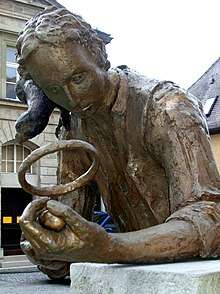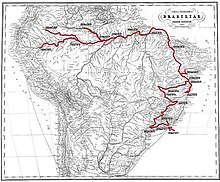Johann Baptist von Spix
Johann Baptist Ritter von Spix (born February 9, 1781 in Höchstadt an der Aisch , † May 13, 1826 in Munich ) was a German scientist .
Life
Johann Baptist Spix was the seventh of eleven children. A small museum has been housed in the house where he was born since 2004 . Little is known about his childhood. He studied philosophy in Bamberg and received his doctorate. He studied theology in Würzburg , but, under the influence of Friedrich Schelling , broke off studying theology and then studied medicine and natural sciences . He received his doctorate a second time. For a while, he was a resident doctor in Bamberg.
Presumably through the influence of Schelling, who in the meantime reformed the academy in Munich under Count Maximilian von Montgelas , Spix was called to Munich. King Maximilian I of Bavaria granted him a scholarship to learn the modern methods of zoology in Paris . Spix used the opportunity to go on marine biological excursions and first scientific investigations.
Spix was appointed adjunct in 1810 and curator in 1811 of the now independent zoological collections in Munich and had the task of reorganizing and expanding them according to scientific criteria. The Zoological State Collection in Munich goes back to this appointment. A comprehensive work on the history and basics of zoological systematics , published in 1811, brought him general scientific recognition. In 1813 he was made a full member of the Bavarian Academy of Sciences .

Johann Baptist Spix joined the Austrian expedition to Brazil in 1817 , but then traveled alone with the younger botanist Carl Friedrich Philipp von Martius from Rio de Janeiro through the interior of Brazil to Goiás and Rio São Francisco until 1820 . Between 1819 and 1820, Spix and Martius also sailed the Amazon . Sometimes they separated in order to explore as much of the country as possible in the given time.
From this expedition, Spix and Martius brought a collection of 6,500 plants, 2,700 insects, 85 mammals, 350 birds, 150 amphibians and reptiles, and 116 fish back to Germany. The animals collected form an important basis for today's zoological collections in Munich. The numerous ethnographic collectibles (dance masks, feather headdresses, weapons, utensils) are in the Museum Five Continents in Munich, some of them are unique. In addition, Spix and Martius also brought coins, minerals, fossils and much more to Munich.
After returning from Brazil, Spix was ennobled and knighted. He was also accepted into various academic societies, received an annuity and many honors. He was able to acquire a property near Lindau on Lake Constance (Alwind), which he could hardly use. His health was probably very weak due to a tropical disease, but was still able to publish a few works in which he scientifically described many animal species. In particular, Spix wrote (with Martius) the work Journey to Brazil ... , in which the journey was described. He was able to finish the first volume for printing himself, the second and third volumes were continued by Martius (partly using Spix's notes). Overall, the work appeared in three volumes, in 1823, 1828 and 1831 with an "atlas ribbon".
Spix died in Munich on May 13, 1826, presumably of a tropical disease. Spix's grave is in the Old Southern Cemetery in Munich. Today's tombstone is a replacement tombstone, as the original tombstone no longer exists.

Johann Andreas Schmeller noted in his diary on the occasion of Spix's death and burial that he should have been buried between the two Indian children whom he had brought from their home to the Munich churchyard. Schmeller had known Spix since July 19, 1816. At that time he had hiked with Spix to the Kaum-Alpe , and even then, according to Schmeller, Spix was “weak and sickly”. Together with "Martinis Wittwe", who ran the business for him, he needed a cure in the Bad von Adelholzen . Schmeller and Spix later met on their favorite walk together on the Grieslein . According to Schmeller, Spix had suffered from Sömmering's harsh judgment of his cephalogenesis before the Brazil expedition and only got "back on his feet" mentally and physically after his trip to Brazil, but even after his return, Spix was mostly depressed .
Scientific importance
Spix described many birds, monkeys and bats, turtles and amphibians from Brazil. In particular his descriptions of the birds of Brazil (1824, two volumes) are of great importance. In this work he also described a blue parrot, which was later named after Spix by his student Johann Georg Wagler : the Spix's Macaw . Due to his early death, however, Spix was unable to complete the scientific processing of much of his material. For example, Louis Agassiz continued the classification of freshwater fish he had found in Brazil, which Spix had begun, and in this way found one of his most important areas of research, ichthyology . The insects were edited by Maximilian Perty . Wagler also described the snakes from Brazil using Spix's notes.
A point of criticism of Spix's work that has been raised on various occasions is the fact that he and Martius brought two Indian children between the ages of around 10 and 14 with them to Munich. This can only be understood from the spirit of the time. The two children were named Juri or Johannes and Miranha or Isabella. The names Juri and Miranha refer to the people from which they came, we do not know their actual names (Isabella and Johannes were the Christian names they were baptized with). Since they were of different ethnicities, they could not communicate with each other. Despite medical care, the two soon died in Munich. Your grave relief by Johann Baptist Stiglmaier has been preserved.
In 1820 Spix became a member of the Leopoldina .
Spix was variously referred to as the "Bavarian Humboldt ". The scientific importance of Spix was especially recognized by the former director of the Zoological State Collection Ernst Josef Fittkau (1927–2012) in various publications, after he was in the shadow of Martius, who lived as a professor in Munich for many years after his trip to Brazil and taught. In recent years, Spix's achievements outside of zoology have also been increasingly noted, for example in ethnology and through the discovery of the Santana Formation , today a world cultural heritage.
Spix's birthplace in Höchstadt is now a museum that was redesigned in 2019. It shows Spix's research, exhibits Spix's books, and shows rocks and animals that Spix brought back from Brazil.
Since 1981 the Ritter von Spix Medal has been awarded to particularly deserving patrons and patrons of the Munich State Zoological Collection. In 2015, the University of Bamberg set up a visiting professorship with the name "Johann von Spix Professorship".
Dedication names
- Spix's Macaw (a parrot, discovered by Spix and named after him)
- Spix night monkey and black -headed uakari
- Micrurus spixii (a giant coral snake)
- Santanadactylus spixi (a pterosaur from the Santana Formation )
- Asolene spixi (zebra apple snail)
- Tetracha spixii (a tiger beetle)
- Spixia (a genus of land snails found only in South America)
- Spixiarum (a fossil plant genus from the Santana Formation)
- The genus Spixia closet from the sunflower family (Asteraceae)
For details, literature and other taxa named after Spix, see
Main publications by JB von Spix
- 1811: History and assessment of all systems in zoology according to their evolutionary sequence from Aristotle to the present day. - Nuremberg, Schrag'sche Buchhandlung I-XIV; 710pp.
- 1814: Treatise on the monkeys of the old and the new world in general, especially on the black howling monkey (Simia Belzebul Linné) and on the Moloch (Simia Moloch Hofmannsegg) together with the illustrations of the last two (Tab. XVII, XVIII), and one Directory of all monkey species known to date. - Denkschr. d. Kgl. Akad. D. Knowledge Munich: 321–342, 2 plates for the online version at Bayer. Academy of Science
- 1815: Cephalogenesis sive Capitis Ossei Structura, Formatio et Significatio per omnes Animalium Classes, Familias, Genera ac Aetates digesta, atque Tabulis illustrata, Legesque simul Psychologiae, Cranioscopiae ac Physiognomiae inde derivatae. -Typis Francisci Seraphici Hübschmanni, Monachii: 11 u. 72pp; 9 plate
- 1824: Animalia nova sive species novae Testudinum et Ranarum, quas in itinere per Brasiliam annis MDCCCXVII - MDCCCXX Iussu et Auspiciis Maximiliani Josephi I. Bavariae Regis suscepto collegit et descripsit. - Typis Franc. Seraph. Hübschmanni, Monachii: 1-29, 22 plates - reprinted 1981 Soc. for the Study of Amphibians and Reptiles, Oxford; with an introduction by PE Vanzolini
- 1824: Avium species novae, quas in itinere per Brasiliam Annis MDCCCXVII - MDCCCXX Iussu et Auspiciis Maximiliani Josephi I. Bavariae Regis suscepto collegit et descripsit. -Typis Franc. Seraph. Hübschmanni, Monachii: Tom. I, 1-90, 91 plates; Tom. II, 1-85, 109 plates.
- Wagler, J. (Editor JB Spix) 1824: Serpentum Brasiliensium Species novae ou Histoire Naturelle des especes nouvelles de Serpens, Recueillies et observées pendent le voyage dans l'interieur du Brésil dans les Années 1817, 1818, 1819, 1820… publiée par Jean de Spix,… écrite dàprès les notes du Voyageur by Jean Wagler - Typis Franc. Seraph. Hübschmanni, Monachii: 1-75, 26 plates - reprinted 1981 Soc. for the Study of Amphibians and Reptiles, Oxford; with an introduction by PE Vanzolini
- Spix & Martius 1823–1831: Travel in Brazil on the orders of Sr. Majesty Maximilian Joseph I, King of Bavaria, made and described in the years 1817–1820. 3 volumes and 1 atlas. M. Lindauer publishing house, Munich. 1388pp. (Volumes II and III edited and edited by CFPh. V. Martius) Digitized version of the atlas ; Digitized version of the first volume (Biodiversity Heritage Library) - reprint, 1967, FA Brockhaus Komm. Ges. Abt. Antiquarium, Stuttgart.
literature
- B. Bartkowski: The animal kingdom as an organism in JB v. Spix (1781-1826). His examination of the diversity in the animal kingdom: the “natural” system. (= European university publications. 3rd episode, volume 804) Frankfurt am Main 1998, ISBN 3-631-33807-4 (important and fundamental doctoral thesis on JB von Spix and his work).
- Elke Bujok, Jörg Helbig: The "Brazilian-Bavarian Expedition" by Spix and Martius 1817-1820. In: Munich contributions to ethnology. Volume 15 (2012/2013), pp. 42-71.
- EJ Fittkau: Johann Baptist Ritter von Spix, zoologist and Brazilian researcher. In: J. Helbig (Ed.): Brasilianische Reise 1817–1820. Carl Friedrich von Martius on his 200th birthday. Munich 1994, ISBN 3-7774-6550-X , pp. 29-38.
- T. Heinzeller: On the 225th birthday of the founder of the ZSM: Spix and the dawn of zoology into the modern age. In: Spixiana. Volume 29, Number 3, 2006, pp. 193–197, schoenitzer.de (PDF)
- Brigitte Hoppe: Spix, Johann Baptist Ritter von. In: New German Biography (NDB). Volume 24, Duncker & Humblot, Berlin 2010, ISBN 978-3-428-11205-0 , pp. 727-729 ( digitized version ).
- Karl Heinrich Oberacker: The German contribution to building the Brazilian nation . Herder, São Paulo 1955, pp. 206–209: Karl Friedrich Philipp von Martius and Johann Baptist von Spix.
- Friedrich Ratzel: Spix, Johann Baptist von . In: Allgemeine Deutsche Biographie (ADB). Volume 35, Duncker & Humblot, Leipzig 1893, p. 231 f.
- Klaus Schönitzer : A life for zoology. The journeys and researches of Johann Baptist Ritter von Spix. Allitera Verlag, edition monacensia, Munich 2011, ISBN 978-3-86906-179-5 .
Web links
- Website about Spix with a directory of his publications
- Literature by and about Johann Baptist von Spix in the catalog of the German National Library
- Zoological State Collection Munich
- Excerpt from Spixiana 16, pp. 96-104. (PDF)
Individual evidence
- ^ Page of the city of Höchstadt an der Aisch
- ↑ Quoted from Martius in the travel description, Volume 3, 1831 (Spix and Martius did not differentiate between amphibians and reptiles)
- ^ E. Bujok, J. Helbig: The "Brazilian-Bavarian Expedition" by Spix and Martius 1817-1820 . In: Jahrb. Staatl. Museum f. Ethnology Munich . tape 15 , 2013, p. 42-71 .
- ↑ Grave field 5 - row 1 - place 21 ( location )
- ↑ Berta and Walter Huber: Dr. Johann Baptist von Spix - A "famous Munich personality". In: Spixiana. 16, 1993, pp. 97-104.
- ↑ Reinhard Bauer, Ursula Münchhoff (ed.): "Lauter mowed meadows for the reaction". The first half of the 19th century in the diaries of Johann Andreas Schmeller. Munich 1990, ISBN 3-492-10884-9 , p. 139 f. Schmeller recapitulated his acquaintance with Spix in the diary entry of May 13, 1826 and commented on the funeral on May 15, 1826.
- ↑ Klaus Schönitzer: A life for zoology - The journeys and researches of Johann Baptist Ritter von Spix . Allitera Verlag, edition monacensia, Munich 2011, ISBN 978-3-86906-179-5 , p. 164-174 .
- ↑ Helmut Sick: The importance of Johann Baptist von Spix for the study of the bird world in Brazil . In: Spixiana Supplement . tape 9 . Munich 1983, p. 29-31 .
- ↑ Klaus Schönitzer, Michael Franzen: Johann Baptist von Spix (1781-1826) and his research into the herpetofauna of Brazil . In: A. Kwet, M. Niekisch (Ed.): Mertensiella . tape 23 . Basilisken-Presse, Rangsdorf 2016, ISBN 978-3-941365-53-7 , p. 80-90 .
- ^ H. Leonhardt: Relentlessly rough winter in the north. A story. Weismann Verlag, Munich 1987.
- ^ Klaus Schönitzer: From the new to the old world. Two indigenous children brought back to Germany by Johann Baptist Spix and Carl Friedrich Philipp Martius . In: Journal Five Continents. Forum for Ethnological Research . tape 1 . Munich 2015, ISBN 978-3-927270-75-6 , pp. 79-105 ( schoenitzer.de [PDF]).
- ↑ grave relief of the Indian children Yuri and Miranha on www.muenchner-stadtmuseum.de
- ^ List of members Leopoldina, Johann Baptist von Spix
- ↑ z. BK Dütsch: The Bavarian Humboldt. (PDF; 142 kB). In: Topicos. 01/2013, p. 43 and Feathered World. (03/2012) March 20, 2012.
- ↑ see Fittkau 1994, further literature in Schönitzer 2011.
- ↑ for example in the introduction to the reprint of the journey in Brazil by Mägdefrau, reprint 1967, Stuttgart, pp. I – XII; L. Schrott: The naturalists Martius and Spix. In: Bavarian world drivers. Munich 1964, DNB 454487843 , pp. 182-197.
- ↑ Klaus Guth: With the eyes of the stranger. Research on the indigenous population of Brazil by Johann Baptist von Spix (1781–1826) and Carl Philipp Friedrich von Martius (1794–1868) - requirements, working methods, attitudes. In: Yearbook for Franconian State Research. 69, 2009, pp. 213-228; E. Bujok: Johann Baptist von Spix and Karl Friedrich Philipp von Martius. In: Exotic Worlds Dettelbach. 2007, pp. 81-94.
- ^ A. Herzog, A. Sales, G. Hillmer: The UNESCO Araripe Geopark. A short story of the evolution of life, rocks and continents. Fortaleza 2008.
- ↑ Lots of room for Spix in Höchstadt. Retrieved April 14, 2019 .
- ^ Winner of the Ritter von Spix Medal. Retrieved January 7, 2018 .
- ^ First Johann von Spix Professorship awarded . ( uni-bamberg.de [accessed on January 7, 2018]).
- ↑ Clément Coiffard, Barbara AR Mohr, Mary EC Bernardes-de-Oliveira: The Early Cretaceous Aroid, Spixiarum kipea gen. Et sp. nov., and implications on early dispersal and ecology of basal monocots. In: Taxon. 62 (5), 2013, pp. 997-1008.
- ↑ Lotte Burkhardt: Directory of eponymous plant names - Extended Edition. Part I and II. Botanic Garden and Botanical Museum Berlin , Freie Universität Berlin , Berlin 2018, ISBN 978-3-946292-26-5 doi: 10.3372 / epolist2018 .
- ↑ Schönitzer 2011, pp. 192–201.
| personal data | |
|---|---|
| SURNAME | Spix, Johann Baptist von |
| ALTERNATIVE NAMES | Spix, Johann Baptist Ritter von (full name) |
| BRIEF DESCRIPTION | German natural scientist |
| DATE OF BIRTH | February 9, 1781 |
| PLACE OF BIRTH | Höchstadt an der Aisch |
| DATE OF DEATH | May 13, 1826 |
| Place of death | Munich |


